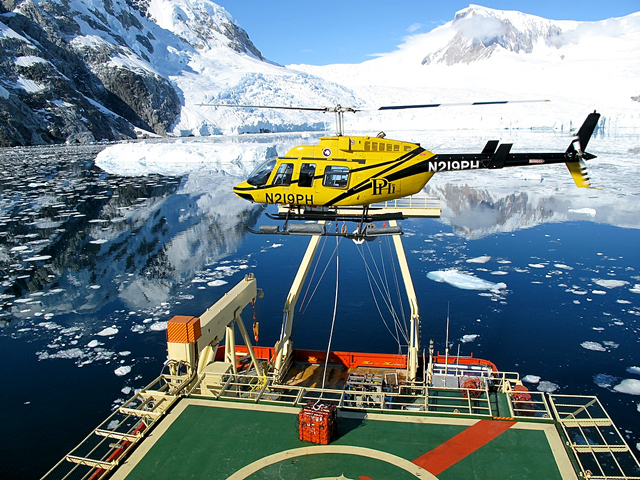Surface meltStudy suggests Larsen B Ice Shelf collapsed from the top downPosted September 26, 2014
Newly published research on the geologic history of the Antarctic Peninsula, specifically an area where a large, floating ice shelf disintegrated in the early 2000s, indicates that the cataclysmic break-up was primarily a result of rising air temperatures and melting at the ice surface. The recent findings support the idea that a warming of the ice surface and its after-effects – such as the development of melt ponds and crevasses, or cracks, in the surface of the ice that allow warmer water to infiltrate downward into the ice – could cause such a dramatic collapse. NSF-funded research
Eugene Domack, Hamilton College (now University of South Florida), Award Nos.
0732467
Amy Leventer, Colgate University,
Award No. 0732625
Stefanie Brachfeld, Montclair State University,
Award No. 0732605
The findings were published in the Sept. 11 edition of the journal Science. The under-cutting of the bottom of an ice shelf by relatively warm ocean water also causes ice shelves to collapse, and scientists have demonstrated such occurrences in Antarctica and Greenland. But the new study indicates that most changes at the base of the Larsen B Ice Shelf on the Antarctic Peninsula, the portion of Antarctica that extends northwards toward South America, had already occurred at the end of the last ice age. “Now, we can recognize two distinct mechanisms for the destabilization of ice shelves,” said Eugene Domack, a lead author on the paper and a professor of geological oceanography at the University of South Florida, in a press release The research involved an international team of researchers and focuses on the 2002 disintegration of the Larsen B, a slab of ice the size Rhode Island and located on the eastern coast of the Antarctic Peninsula. The research was supported by the Division of Polar Programs Scientists with the LARISSA project participated in several research cruises to the Antarctic Peninsula to collect data about the area’s response to past climate changes and to examine more recent behavior after the ice shelf disappeared. Samples had also been collected by Domack and colleagues during research cruises in 2005 and 2006. The new work has major implications for the study of ice-sheet dynamics, which are important in understanding how the vast Antarctic ice sheets will behave, as global temperature increase. The Antarctic Peninsula is one of the fastest-warming places on the planet, with temperatures increasing by about a half-degree Celsius per decade since the 1950s. Ice shelves play a vital role in the behavior of the enormous mass of freshwater ice that covers the Antarctic continent, acting as dams that regulate the flow of ice into the sea. The Antarctic ice sheet contains enough freshwater to raise global sea level by about 60 meters. Earlier this year, researchers published findings indicating that such a collapse may have begun in another part of Antarctica, a process that is expected to take centuries to complete. However, the potential response of the ice sheet to increases in air temperature can be much faster. Co-authors on the Science paper include: M. Rebesco, E. Domack, F. Zgur, C. Lavoie, A. Leventer, S. Brachfeld, V. Willmott, G. Halverson, M. Truffer, T. Scambos, J. Smith, E. Pettit. |



For USAP Participants |
For The Public |
For Researchers and EducatorsContact UsU.S. National Science FoundationOffice of Polar Programs Geosciences Directorate 2415 Eisenhower Avenue, Suite W7100 Alexandria, VA 22314 Sign up for the NSF Office of Polar Programs newsletter and events. Feedback Form |


